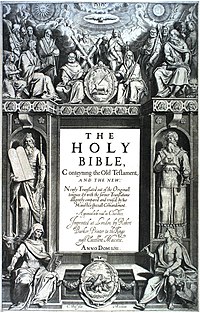| King James Version | |
|---|---|
 The title page to the 1611 first edition of the authorized version of the Bible by Cornelis Boel shows the Apostles Peter and Paul seated centrally above the central text, which is flanked by Moses and Aaron. In the four corners sit Matthew, Mark, Luke and John, the traditionally attributed authors of the four gospels, with their symbolic animals. The rest of the Apostles (with Judas facing away) stand around Peter and Paul. At the very top is the Tetragrammaton "יְהֹוָה" written with niqqud. | |
| Abbreviation | KJV[a] |
| Complete Bible published | 1611 |
| Online as | King James Version at Wikisource |
| Textual basis | OT: Masoretic Text Apocrypha: Septuagint and Vulgate NT: Textus Receptus |
| Translation type | Formal equivalence[1] |
| Version revision | 1769 |
| Copyright | Public domain[b] |
| Religious affiliation | Anglican[1][c] |
For God so loved the world, that he gave his only begotten Son, that whosoever believeth in him should not perish, but have everlasting life. | |
The King James Version (KJV), also the King James Bible (KJB) and the Authorized Version (AV), is an Early Modern English translation of the Christian Bible for the Church of England, which was commissioned in 1604 and published in 1611, by sponsorship of King James VI and I.[d][e] The 80 books of the King James Version include 39 books of the Old Testament, 14 books of Apocrypha, and the 27 books of the New Testament.
Noted for its "majesty of style", the King James Version has been described as one of the most important books in English culture and a driving force in the shaping of the English-speaking world.[3][4] The King James Version remains the preferred translation of many Protestant Christians, and is considered the only valid one by some Evangelicals. It is considered one of the important literary accomplishments of early modern England.
The KJV was the third translation into English approved by the English Church authorities: The first had been the Great Bible (1535), and the second had been the Bishops' Bible (1568).[5] In Switzerland the first generation of Protestant Reformers had produced the Geneva Bible[6] which was published in 1560[7] having referred to the original Hebrew and Greek scriptures, which was influential in the writing of the Authorized King James Version.
The English Church initially used the officially sanctioned "Bishops' Bible", which was hardly used by the population. More popular was the named "Geneva Bible", which was created on the basis of the Tyndale translation in Geneva under the direct successor of the reformer John Calvin for his English followers. However, their footnotes represented a Calvinistic Puritanism that was too radical for James. The translators of the Geneva Bible had translated the word king as tyrant about four hundred times—the word tyrant does not appear once in the KJV. Because of this, it has been assumed King James purposely had the translators of the KJV translate the word tyrant as either "troubling", "oppressor", or some other word to avoid people being critical of his monarchy.
James convened the Hampton Court Conference in January 1604, where a new English version was conceived in response to the problems of the earlier translations perceived by the Puritans,[8] a faction of the Church of England.[9] James gave translators instructions intended to ensure the new version would conform to the ecclesiology, and reflect the episcopal structure, of the Church of England and its belief in an ordained clergy.[10][11] In common with most other translations of the period, the New Testament was translated from Greek, the Old Testament from Hebrew and Aramaic, and the Apocrypha from Greek and Latin. In the 1662 Book of Common Prayer, the text of the Authorized Version replaced the text of the Great Bible for Epistle and Gospel readings, and as such was authorized by an Act of Parliament.[12]
By the first half of the 18th century, the Authorized Version had become effectively unchallenged as the only English translation used in Anglican and other English Protestant churches, except for the Psalms and some short passages in the Book of Common Prayer of the Church of England. Over the 18th century, the Authorized Version supplanted the Latin Vulgate as the standard version of scripture for English-speaking scholars. With the development of stereotype printing at the beginning of the 19th century, this version of the Bible had become the most widely printed book in history, almost all such printings presenting the standard text of 1769, and nearly always omitting the books of the Apocrypha. Today the unqualified title "King James Version" usually indicates this Oxford standard text.
Cite error: There are <ref group=lower-alpha> tags or {{efn}} templates on this page, but the references will not show without a {{reflist|group=lower-alpha}} template or {{notelist}} template (see the help page).
- ^ a b "Bible Translation Spectrum". Logos Bible Software Wiki. Archived from the original on 7 January 2023. Retrieved 7 January 2023.
- ^ KJV Dedicatorie 1611.
- ^ Cite error: The named reference
hunt20110209was invoked but never defined (see the help page). - ^ "The King James Bible: The Book That Changed the World – BBC Two". BBC.
- ^ Daniell 2003, p. 204.
- ^ The Sixth Point of Calvinism, The Historicism Research Foundation, Inc., 2003, ISBN 09620681-4-4
- ^ The Holy Bible ... With a General Introduction and Short Explanatory Notes, by B. Boothroyd. James Duncan. 1836.
- ^ Daniell 2003, p. 435.
- ^ Hill 1997, pp. 4–5.
- ^ Daniell 2003, p. 439.
- ^ Daniell 2003, p. 436.
- ^ Daniell 2003, p. 488.